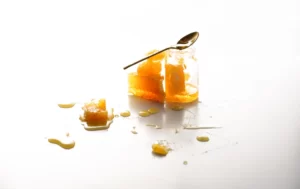Table of Contents
- Introduction
- The Difference between Raw Manuka and Hospital-Grade Manuka Honey
- What Strength of Manuka Honey Should You Use for Scars?
- The Importance of Further Studies on Manuka Honey for Scars
- Burns vs. Wounds: When to Seek Medical Attention
- How Manuka Honey Helps Treat Scars
- How to Use Manuka Honey for Scars
Introduction
For centuries, honey has been used as a medicinal remedy for burns and wounds. Ancient civilizations such as the Sumerians, Egyptians, Greeks, and Romans recognized the healing properties of honey and incorporated it into their traditional medicine practices. Religious texts like the Bible and Quran mention honey, and it holds a significant place in ancient Ayurvedic and Chinese medicine. Even today, honey is recommended by dieticians, holistic doctors, and some medical professionals. In this article, we will explore the healing properties of manuka honey specifically for scars. We will discuss the difference between raw manuka honey and the manuka honey used in hospitals, the recommended strength for different types of scars, the importance of further studies on manuka honey, and how to effectively use honey for scar treatment.
The Difference between Raw Manuka and Hospital-Grade Manuka Honey
Raw honey is pure, unadulterated honey that has not undergone pasteurization or been heated above hive temperature. The main distinction between raw manuka honey and hospital-grade manuka honey is the treatment process. Hospital-grade honey is typically subjected to high heat or gamma radiation to sterilize the honey.
While sterilizing honey does eliminate some of the raw benefits and diminishes its ability to provide nutrients like amino acids, vitamins, and minerals, it does not affect the MGO (methylglyoxal) content. MGO is the antibacterial, antimicrobial, and anti-inflammatory component of manuka honey, making it effective for medicinal use.
Although some argue that sterilizing manuka honey is unnecessary since untreated honey has been used for centuries without adverse side effects, the sterilization process ensures the honey’s safety in medical settings. Manuka honey is the preferred choice in hospitals due to its high levels of MGO, which has been found to be more effective than standard honey for most medicinal uses.
What Strength of Manuka Honey Should You Use for Scars?
The strength of manuka honey to use depends on the severity of the scar. For minor scars, a low MGO (60+) honey is usually sufficient. However, more severe scars may require higher activity honey.
While “medical grade” honey is not an officially recognized grading system, you may come across this term on packaging. It is important to note that the MGO content determines the honey’s quality and effectiveness, not the label “medical grade.” When selecting a manuka honey product, look for the MGO content.
At https://aboutmanukahoney.com, we offer manuka honey with grades up to 1000+ MGO, which is suitable for new surgical scars, severe scars, and non-healing scars. It is always recommended to consult with your doctor or healthcare professional for proper treatment recommendations.
Generally, honey with an MGO of 400+ and up is recommended for external purposes or more severe internal issues such as significant inflammation, injury to the stomach lining, chemotherapy, and other medical conditions that require anti-inflammatory properties.
The Importance of Further Studies on Manuka Honey for Scars
While there is evidence dating back centuries and some promising current studies on the use of honey for medicinal purposes, more research is needed, especially given the growing threat of antibiotic resistance.
Antibiotic resistance is a significant global health concern caused by the overuse of antibiotics and the ability of microorganisms to evolve and survive. Honey has never caused bacterial resistance and has been shown to be effective against antibiotic-resistant organisms. Manuka honey, in particular, is effective against bacteria such as Pseudomonas, staph infections, and MRSA.
Further studies on manuka honey and its healing properties for scars can provide valuable insights and alternative treatment options, particularly in the face of increasing antibiotic resistance.
Burns vs. Wounds: When to Seek Medical Attention
Burns and wounds are distinct types of injuries that require varying levels of medical attention. It is crucial to understand the severity of your injury and seek appropriate medical care when necessary. Here are the different types of burns and wounds and when to seek treatment:
Types of Burns and When to Seek Treatment
First-Degree Burns or Superficial Burns:
– These are mild burns that cause pain and reddening of the outer layer of the skin or epidermis.
– Examples include minor cooking burns or sunburns.
– No medical treatment is usually needed for these burns.
Second-Degree Burns or Partial Thickness Burns:
– These burns affect the outer layer of the skin or epidermis and the lower layer of the dermis.
– Examples include burns from boiling water, chemical heat packs, curling irons, or friction burns.
– While no medical treatment is typically needed, use your discretion and seek medical attention if necessary.
Third-Degree Burns or Full Thickness Burns:
– These burns penetrate the lower layer of the skin or dermis and affect deeper tissues.
– They require immediate medical attention and can be caused by prolonged exposure to scalding liquid, flames, or electric or chemical sources.
Fourth-Degree Burns:
– These burns extend beyond the third-degree burns and can impact muscles and bones.
– Seek immediate medical attention if you experience this type of burn.
– They are typically caused by prolonged flame exposure, scalding oils, or electric or chemical sources.
Types of Wounds and When to Seek Treatment
Penetrating Wounds:
– This category includes surgical wounds, puncture wounds, burns from thermal, chemical, or electric sources, bites and stings, blunt force trauma, abrasions, lacerations, and skin tears.
– Use your discretion to determine if medical attention is needed.
Closed Wounds:
– This category includes contusions, blisters, seroma, hematoma, crush injuries, ulcers, and other closed injuries.
– Again, use your discretion to determine if medical attention is necessary.
When in doubt, it is always better to seek medical attention to ensure proper care and treatment for your scars.
How Manuka Honey Helps Treat Scars
Manuka honey possesses several beneficial properties that make it effective in treating scars. When applied to scars, manuka honey:
– Reduces inflammation, which can help minimize scar tissue formation.
– Reduces scar contractures, promoting more flexible and less visible scars.
– Neutralizes free radicals, which can contribute to scar discoloration and aging.
– Stimulates tissue repair processes, aiding in the regeneration of healthy skin cells.
– Exhibits high antibacterial effectiveness, preventing infection in open wounds and reducing the risk of scar-related complications.
– Strengthens the immune system, supporting overall healing and scar recovery.
– Creates a moist environment for skin cell regrowth, promoting faster healing and minimizing scar formation.
– Provides necessary nutrients like amino acids, vitamins, and minerals for the production of healthy skin tissue.
– Acts as a physical barrier against infection, protecting the scar from external contaminants.
– Cleans and deodorizes wounds, reducing the risk of infection and unpleasant odors.
– Promotes epithelialization, the process by which new skin cells cover the wound and aid in scar formation.
– Alleviates pain and provides a soothing effect, making the scar healing process more comfortable.
These functions of manuka honey have been backed by various studies. For more details on each function and the corresponding research studies, please refer to the sources mentioned in the following links: source1, source2, source3.
How to Use Manuka Honey for Scars
When using manuka honey for scars, it is important to follow proper application methods. Here is a step-by-step guide:
- Clean the area: Before applying honey, clean the scar with a diluted honey and water mixture or a saline solution. This helps remove any debris and prevents infection.
- Apply the honey: Use a clean finger or a sterile applicator to apply a thin layer of manuka honey directly onto the scar. Ensure that the honey covers the entire scarred area.
- Massage the honey: Gently massage the honey into the scarred area using circular motions. This helps improve blood circulation and absorption of the honey.
- Cover the scar: After applying the honey, cover the scar with a sterile dressing or bandage. This helps keep the honey in place and protects the scar from further contamination.
- Monitor and change dressings: Check the scar regularly for any signs of infection or worsening. Change the dressing and reapply honey as needed, following proper hygiene practices.
It is important to note that manuka honey may cause a temporary stinging sensation when applied to open scars. This is normal and usually subsides quickly.
In conclusion, manuka honey has been used for centuries for its healing properties, especially in the treatment of scars. It offers numerous benefits, including its antibacterial effectiveness, anti-inflammatory properties, and ability to promote tissue repair. While further studies are needed to fully understand its potential, manuka honey can be a valuable addition to your scar treatment routine. Always consult with your healthcare professional for proper treatment recommendations and to determine the appropriate strength of manuka honey for your specific needs.



